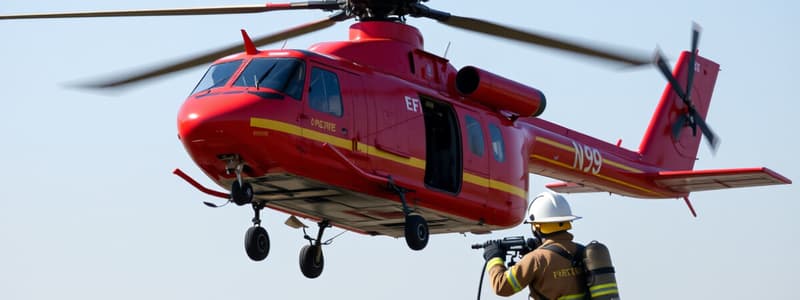Podcast
Questions and Answers
What is the primary purpose of sector officers providing pessimistic reports to command?
What is the primary purpose of sector officers providing pessimistic reports to command?
- To highlight the successes of the crew's efforts
- To ensure adequate resources are available until benchmarks are met (correct)
- To request an evaluation of tactical operations
- To downplay the need for resources in the sector
Why is maintaining adequate 'on-deck' resources critical for sector operations?
Why is maintaining adequate 'on-deck' resources critical for sector operations?
- It ensures that all crews are exposed to hazards equally
- It allows crews to spend more time in the hazard zone
- It provides crews to cycle into the hazard zone and respond to emergencies (correct)
- It helps in lowering the risk of operational delays
What factor is emphasized as critical in determining risk management within a sector?
What factor is emphasized as critical in determining risk management within a sector?
- The speed of resource deployment
- The leadership experience of the sector officers
- The number of personnel present on the fireground
- Crew air management (correct)
What should sector officers do if critical fireground factors change negatively?
What should sector officers do if critical fireground factors change negatively?
What is the main concern for sector officers regarding their crew?
What is the main concern for sector officers regarding their crew?
What is the primary responsibility of the initial sector officer during rapidly escalating fire incidents?
What is the primary responsibility of the initial sector officer during rapidly escalating fire incidents?
Which officer is typically tasked with monitoring work/rest cycles within a sector?
Which officer is typically tasked with monitoring work/rest cycles within a sector?
What does the sector officer need to perform in order to ensure crew operations align with risk management?
What does the sector officer need to perform in order to ensure crew operations align with risk management?
What is one significant challenge the initial sector officer faces while managing air consumption?
What is one significant challenge the initial sector officer faces while managing air consumption?
During a fire incident, which level of sector management has more direct control over individual crew air management?
During a fire incident, which level of sector management has more direct control over individual crew air management?
What is a key responsibility of the Battalion Chief in managing the sector operations?
What is a key responsibility of the Battalion Chief in managing the sector operations?
What is a significant task of the F.I.T./I.S.O. during operations in the hazard zone?
What is a significant task of the F.I.T./I.S.O. during operations in the hazard zone?
What must sector officers ensure regarding actions within their sector?
What must sector officers ensure regarding actions within their sector?
Flashcards are hidden until you start studying
Study Notes
Tactical Level of Air Management
- Company officers take on the role of initial sector officer during rapidly escalating fire incidents, managing tactical air management for their sector.
- The first Captain on the scene works directly with their crew, overseeing tactical objectives and assigning operational tasks.
- Initial sector officers may struggle to manage the air consumption of all crews assigned to their sector and require support from other captains for effective air monitoring.
- As incidents escalate, a tactical level Chief Officer must be assigned to oversee sector operations.
Battalion Chief Level Sector Management
- Battalion Chiefs have more direct control over crew air management than the incident commander but usually operate from outside the hazard zone.
- Close management of work cycles and accountability is crucial for monitoring crew air supplies; this is facilitated by the Battalion Chief and the Field Incident Technician (F.I.T.) or Incident Safety Officer (I.S.O.).
- The F.I.T./I.S.O. is responsible for monitoring work/rest cycles and notifying crews about the elapsed time of their SCBA air supply.
- Sector officers must conduct their hazard assessments and apply standard decision-making models to ensure strategies align with risk management profiles.
Responsibilities of Sector Officers
- Sector officers define crew operations within the structure, balancing task completion with air management and maintaining clear exit plans.
- It is essential to provide detailed resource needs to command, ensuring uninterrupted work cycles within the sector until tactical benchmarks are achieved.
- Maintaining adequate “on-deck” resources is critical for swift crew replacements within the hazard zone and for addressing potential “Mayday” situations.
- Early resource forecasting is vital for informing command of overall incident requirements and ensuring crew welfare, which is a top priority for sector officers.
- Air management is a crucial factor in determining the risk profile of the sector; any negative changes should be communicated to command, prompting a strategy reevaluation.
Studying That Suits You
Use AI to generate personalized quizzes and flashcards to suit your learning preferences.




